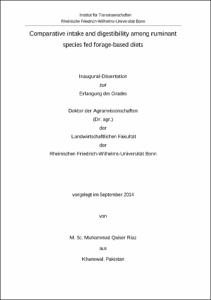Riaz, Muhammad Qaiser: Comparative intake and digestibility among ruminant species fed forage-based diets. - Bonn, 2015. - Dissertation, Rheinische Friedrich-Wilhelms-Universität Bonn.
Online-Ausgabe in bonndoc: https://nbn-resolving.org/urn:nbn:de:hbz:5n-38872
Online-Ausgabe in bonndoc: https://nbn-resolving.org/urn:nbn:de:hbz:5n-38872
@phdthesis{handle:20.500.11811/6223,
urn: https://nbn-resolving.org/urn:nbn:de:hbz:5n-38872,
author = {{Muhammad Qaiser Riaz}},
title = {Comparative intake and digestibility among ruminant species fed forage-based diets},
school = {Rheinische Friedrich-Wilhelms-Universität Bonn},
year = 2015,
month = feb,
note = {The first ruminants evolved about 50 million years ago and were small forest dwelling omnivores. Today there are about 200 species of ruminants which include both wild and domestic species. Cattle, sheep, and goats account for about 95% of the total population of domestic ruminants. The present thesis aimed at studying various comparative aspects of feed intake and digestibility among different domestic ruminant species, therefore, this work was structured in two major parts. The first part dealt with dataset on voluntary feed intake, digestibility and composition of basal diets and supplements of the domestic ruminant species, i.e., sheep, goats, cattle and buffaloes by pooling data from previously published studies. A meta-analysis of these studies was performed to determine whether there is a common scaling exponent for dry matter intake (DMI) among domestic ruminant species or if this exponent is species specific, and to investigate the influence of dietary nutrient composition on DMI and digestibility. Distinguishable, i.e. species-specific, scaling factors for the relationship between DMI and body weight were estimated, and the difference was pronounced between small and large ruminants with lower exponents for sheep and goats and higher for cattle and buffaloes. Across all ruminant species, crude protein (CP) had a positive influence on intake and digestibility while fibre fractions influenced DMI negatively except for buffaloes who responded positively to acid detergent fibre (ADF). Digestibility was also negatively influenced by ADF in all species, whereas neutral detergent fibre had a negative effect in cattle only. However, the magnitude of the response of feed intake and digestibility to varying concentrations of dietary constituents differed among the ruminant species. Whereas, second part of the study focused on evaluation of digestibility of wheat silage-based diets harvested at different stages of maturity in cattle and sheep. The diets were fed at maintenance or ad libitum intake. Two digestibility methods were compared, the total faecal collection method and titanium(IV)-oxide marker method. The influence of species and diet type was significant on diets digestibility. No significant differences between the methods as well as species and diets for marker recovery except with significant impact of species on titanium(IV)-oxide at ad libitum feeding were recorded. Also non-significant differences among variables’ interactions except for significant effect of species and diet interaction on CP digestibility at ad libitum intake were observed. This trend confirmed that titanium(IV)-oxide is a robust external marker and can be used in digestion studies across different animal species and diet types.},
url = {https://hdl.handle.net/20.500.11811/6223}
}
urn: https://nbn-resolving.org/urn:nbn:de:hbz:5n-38872,
author = {{Muhammad Qaiser Riaz}},
title = {Comparative intake and digestibility among ruminant species fed forage-based diets},
school = {Rheinische Friedrich-Wilhelms-Universität Bonn},
year = 2015,
month = feb,
note = {The first ruminants evolved about 50 million years ago and were small forest dwelling omnivores. Today there are about 200 species of ruminants which include both wild and domestic species. Cattle, sheep, and goats account for about 95% of the total population of domestic ruminants. The present thesis aimed at studying various comparative aspects of feed intake and digestibility among different domestic ruminant species, therefore, this work was structured in two major parts. The first part dealt with dataset on voluntary feed intake, digestibility and composition of basal diets and supplements of the domestic ruminant species, i.e., sheep, goats, cattle and buffaloes by pooling data from previously published studies. A meta-analysis of these studies was performed to determine whether there is a common scaling exponent for dry matter intake (DMI) among domestic ruminant species or if this exponent is species specific, and to investigate the influence of dietary nutrient composition on DMI and digestibility. Distinguishable, i.e. species-specific, scaling factors for the relationship between DMI and body weight were estimated, and the difference was pronounced between small and large ruminants with lower exponents for sheep and goats and higher for cattle and buffaloes. Across all ruminant species, crude protein (CP) had a positive influence on intake and digestibility while fibre fractions influenced DMI negatively except for buffaloes who responded positively to acid detergent fibre (ADF). Digestibility was also negatively influenced by ADF in all species, whereas neutral detergent fibre had a negative effect in cattle only. However, the magnitude of the response of feed intake and digestibility to varying concentrations of dietary constituents differed among the ruminant species. Whereas, second part of the study focused on evaluation of digestibility of wheat silage-based diets harvested at different stages of maturity in cattle and sheep. The diets were fed at maintenance or ad libitum intake. Two digestibility methods were compared, the total faecal collection method and titanium(IV)-oxide marker method. The influence of species and diet type was significant on diets digestibility. No significant differences between the methods as well as species and diets for marker recovery except with significant impact of species on titanium(IV)-oxide at ad libitum feeding were recorded. Also non-significant differences among variables’ interactions except for significant effect of species and diet interaction on CP digestibility at ad libitum intake were observed. This trend confirmed that titanium(IV)-oxide is a robust external marker and can be used in digestion studies across different animal species and diet types.},
url = {https://hdl.handle.net/20.500.11811/6223}
}






